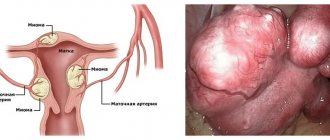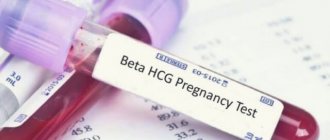How does conception occur?
Is the woman on day 22 of her cycle? Signs of pregnancy may not appear at this moment. This is normal, especially if the girl has a stable menstrual cycle of average duration.
How does conception occur? It is also important to know this. Sometimes, it is this information that helps to suspect pregnancy in the early stages.
In each “monthly cycle,” an egg begins to mature in the girl’s body. It develops in the follicle. By the middle of the cycle, the follicle ruptures. After this, the egg “slips out” into the body. This moment is considered to be ovulation.
Next, the female reproductive cell moves through the fallopian tubes to the uterine cavity. If a sperm penetrates during this time, a fertilized egg is formed. In a few days it will attach to the uterus and begin its development. Otherwise, the unfertilized egg dies in the uterine cavity after a couple of days.
On the 22nd day of the cycle, signs of pregnancy are almost imperceptible during a normal menstrual cycle. However, if you try, you can suspect an “interesting situation” quite early.
Average cycle
What kind of feedback is left on day 22 of the cycle? Signs of pregnancy may appear during a 28-day cycle. Many women talk about this.
The thing is that ovulation occurs under such circumstances on the 12-15th day after the first day of the next menstruation. By day 22, fertilization has already occurred. Most likely, the fertilized egg has already attached to the uterus. This means you can look for the first signs of an “interesting situation.”
Unfortunately, most often they manifest themselves in exactly the same way as PMS. And therefore it is very easy to confuse pregnancy with impending menstruation. More precisely, this is what usually happens - women on the 22nd day of the cycle cannot distinguish the signs of pregnancy from PMS. Moreover, even doctors are unlikely to be able to help cope with the task.
How to calculate without errors what days you can get pregnant?
Calculating the days on which you can conceive a child is not so easy. To do this, you need to analyze the entire menstrual cycle, taking data for the last 6-12 months. If hormonal contraceptives were used at this time, the calculation results may be incorrect.
In order not to forget what days your period occurs, you should keep a special calendar. If the menstrual cycle is not regular, then it will not be possible to determine on which days you can get pregnant. It is best in such cases to use other methods of calculating favorable periods for conception.
If minor deviations are observed during the time period under study, then the following step-by-step calculation can be made:
- Identify the longest and shortest menstrual cycles for 6-12 months;
- Subtract the number 18 from the number of days of the short cycle. The result obtained is the day from which the period with a high probability of getting pregnant begins. For example, the shortest cycle is 25 days. Subtracting 18, we end up with the number 7. This means that the favorable period for conception begins on the 7th day of the menstrual cycle;
- Subtract the number 11 from the number of days of the longest period. The result obtained is the day that ends the period with a high probability of getting pregnant. For example, the longest cycle is 29 days. Subtracting 11, we get the number 18. Thus, on the 18th day of the menstrual cycle, the favorable period for conception ends;
From this example it is clear that the highest probability of becoming pregnant remains in the period from the 7th to the 18th day.
Is it possible to conceive before menstruation?
A definite answer to this question cannot be given. Conception may or may not happen. First, let's figure out why the above question can be answered in the negative.
As you know, ovulation occurs in the middle of the cycle. Before the start of menstruation, the egg dies. If ovulation occurs much later or repeatedly, then an interesting situation may not occur, since the woman’s hormonal background will be adjusted to a new cycle.
Now we will explain why conception can occur before menstruation. Healthy women who have irregular sex life have a fairly high chance of becoming pregnant. Conception can occur after any sexual intercourse.
The body can react to such a rare event with unscheduled ovulation. It can also be triggered by substances contained in semen. Women who regularly have sex with a regular partner may not encounter this.
Short cycle
The second scenario is the onset of pregnancy in a woman with a short menstrual cycle. Usually this is a break between critical days lasting from 20 to 22 days. It follows that a cycle of 23-28 days is normal. This information can be useful to everyone.
Is the woman on day 22 of her cycle? Signs of pregnancy with a short interval between menstruation are more noticeable than with a normal “break” between critical days. Why?
This is due to the fact that with a short duration of the monthly cycle, menstruation comes early. Moreover, on the 22nd day there is often a delay. It is considered the very first and most obvious manifestation of an “interesting situation.”
Unfortunately, the pregnancy test in this case will not always show 2 stripes. This is caused by very low levels of hCG in the urine. A similar hormone appears in a girl’s body only during pregnancy. This means that its presence may indicate successful conception.
What sensations and signs reliably indicate pregnancy?
How wonderful it would be if the very next day after conception the uterus signaled to a woman that pregnancy had occurred with some obvious symptom. But this does not happen and we have to rely only on signs of hormonal changes in the body. Considering that each woman is individual, signs of pregnancy in the early stages may not appear at all, or they may all begin to bother the expectant mother as early as 1 month.
Studies have shown that an egg, as a rule, is fertilized within 12 hours after ovulation (and no longer than 24 hours, because after that it dies). You will begin to notice pregnancy symptoms only after implantation, which occurs 7-10 days after ovulation. The fact is that the embryo begins to produce hCG after its attachment to the wall of the uterus, so it is unlikely that it will be possible to detect any symptoms earlier. The longer you wait before taking a pregnancy test, the more accurate the result and the darker the second line. Ideally, you should take a pregnancy test from the day of your menstruation, which did not occur this month. There are also a number of other reasons that can cause late periods; read about them in our other article.
What are the earliest symptoms?
If you do not observe any of these signs, this does not mean that there is no pregnancy. Perhaps your body reacts differently to conception and changes in hormonal levels do not affect your well-being so much.
No. 1: High basal body temperature
If you regularly monitor your cycle and measure your basal temperature, you will notice that it will remain high throughout the luteal phase. Progesterone causes the temperature to remain high throughout ovulation, and if BBT remains high, this indicates pregnancy. If conception does not occur, then the BT drops and menstruation occurs on its due date.
The most obvious and well-known symptom is that you notice that your period is not on time. But, despite the fact that this symptom is most often attributed to pregnancy, there are a number of other reasons that can lead to a delay. For example, severe stress, serious illness or surgery. On the other hand, many women note the presence of menstruation already during pregnancy. For some, they will continue for several months or even the entire pregnancy.
Another fairly well-known symptom is morning sickness. It, of course, can manifest itself not only in the morning, but also at any time of the day, as soon as the blood sugar level drops significantly. Therefore, you need to monitor regular nutrition. Nausea can occur throughout the first trimester, and some women suffer from this symptom for up to 9 months.
- nipples become tender, sensitive and darken;
- the breast begins to hurt and/or becomes lumpy;
- veins on the chest become noticeable;
- areolas (circles around the nipples) may darken and enlarge;
- small bumps on the areola may become larger or their number may increase.
No. 5: Natural discharge increases
An increase in the hormone progesterone leads to an increase in the amount of cervical mucus. For some women, this symptom may not be noticeable at all, while others have to change panty liners more often.
During your first pregnancy, your metabolism speeds up to support your unborn baby and your own body. This leads to a feeling of endless fatigue. It may seem to you that you constantly want to sleep or at least just relax. Progesterone also has a sedative effect, so many women literally close their eyes from fatigue even during the day. You shouldn’t fight with your body—you just need rest now.
Already a week after conception, you may notice that the urge to go to the toilet begins to occur somewhat more often than usual. This happens because the embryo has already begun to produce hCG, a pregnancy hormone that increases blood supply to the pelvic area. As a result, the bladder signals that it is full even when there is a small amount of urine. This especially bothers women at night.
This symptom causes concern for many women, because they are afraid of miscarriage. However, even if you are not pregnant, your uterus is constantly contracting. This is also normal while expecting a baby, because the fetus grows and puts pressure on the walls of the uterus, which leads to its spasms.
But if these contractions are accompanied by bleeding, then this could indeed be a miscarriage. In this case, you need to contact your gynecologist and an ambulance as quickly as possible. But don't panic - sometimes spotting can be another sign of pregnancy.
Eight to 10 days after ovulation (when your next period is due), you may notice light-colored spotting called implantation bleeding. They are usually not as bright in color as periods.
An increase in hormones leads to the fact that the intestines relax and work worse - this is necessary in order to free up more space for the baby. But as a result, this often leads to constipation. Fortunately, there are many products that can help and are safe for pregnant women.
Smells that never bothered you before can now become a real problem. Even cooking can now be disgusting.
#12: Colds and/or stuffy nose
During normal pregnancy, the woman's immune system is suppressed. This is provided by nature so that the pregnant woman’s body does not reject the fetus as a foreign body. As a result of these hormonal changes, the expectant mother is very susceptible to various types of infections. And the nose is stuffy again due to hormonal effects on the nasal passages.
You may find yourself prone to acne. And even if this trouble has not bothered you before, the period of waiting for a baby quite often leads to acne.
Rising hormone levels in the body can also affect your saliva. You may experience a metallic taste in your mouth that changes the taste of regular foods.
From the very first weeks of pregnancy, a woman may feel either incomprehensible surges of joy or sudden influxes of sadness. Often, irritability becomes a very acute problem and relationships with others begin to deteriorate.
Sometimes a test at a very early stage may not show the coveted second strip. Even if conception has occurred, the hCG level may still be too low for the test to detect its increase. If you think that conception did occur during the last ovulation, then you should wait only 2 weeks and the result will be accurate.
The hospital may offer you several types of pregnancy determination:
- Analysis of urine;
- blood analysis;
- inspection.
To avoid infection, it is better not to do the last procedure. The first two are enough to determine whether the long-awaited pregnancy has occurred.
Do you have any questions? You can ask them on the FORUM
Long cycle
Are you interested in the signs of pregnancy on day 22 of your cycle? Feedback from women emphasizes that there are no specific manifestations of an “interesting situation” at such an early stage. Moreover, each pregnancy for a particular girl can proceed differently. The individual reactions of the human body to certain changes play a huge role. Therefore, next we will consider possible early harbingers of an “interesting situation” in general terms.
A menstrual cycle of 30 days or more is considered long. Then ovulation will occur approximately 14-16 days after the start of your next period. 22 days after the start of the next cycle, there will be no signs of successful conception. Most likely, the woman will not feel them at all.
Normal hCG level for each week of pregnancy
The level of this indicator makes it possible to judge the normal course of pregnancy and identify deviations, so you should familiarize yourself with its norms at each stage of pregnancy.
- In most normal pregnancies, hCG concentrations below 1200 double every 48-72 hours
Days from the first day of the last menstruation Weeks from the first day of the last menstruation Events Average hCG value, honey/ml Norm of hCG, value in honey/ml26 3 weeks +5 days 27 3N +6D 28 4N +0D 29 4N +1D 30 4N +2D 31 4N +3D 32 4N +4D 33 4N +5D 34 4N +6D 35 5N +0D 36 5N +1D 37 5N +2D 38 5N +3D 39 5N +4D 40 5N +5D 41 5N +6D 42 6N 43 6N +1D 44 6N +2D 45 6N +3D 46 6N +4D 47 6N +5D 48 6N +6D 49 7N 50 7N +1D 51 7N +2D 52 7N +3D 53 7N +4D 54 7N +5D 55 7N +6D 56 8N 9-12 weeks 13-16 weeks 17-24 weeks 25-40 weeks
| 25 | 0-50 | |
| 50 | 25-100 | |
| delay of menstruation | 75 | 50-100 |
| 150 | 100-200 | |
| 300 | 200-400 | |
| 700 | 400-1,000 | |
| 1,710 | 1050-2,800 | |
| 2,320 | 1,440-3,760 | |
| 3,100 | 1,940-4,980 | |
| 4,090 | 2,580-6,530 | |
| 5,340 | 3,400-8,450 | |
| 6,880 | 4,420-10,810 | |
| yolk sac | 8,770 | 5,680-13,660 |
| yolk sac | 11,040 | 7,220-17,050 |
| yolk sac | 13,730 | 9,050-21,040 |
| yolk sac | 15,300 | 10,140-23,340 |
| heartbeat | 16,870 | 11,230-25,640 |
| heartbeat | 20,480 | 13,750-30,880 |
| embryo visible | 24,560 | 16,650-36,750 |
| embryo visible | 29,110 | 19,910-43,220 |
| embryo visible | 34,100 | 25,530-50,210 |
| embryo visible | 39,460 | 27,470-57,640 |
| embryo visible | 45,120 | 31,700-65,380 |
| 50,970 | 36,130-73,280 | |
| 56,900 | 40,700-81,150 | |
| 62,760 | 45,300-88,790 | |
| 68,390 | 49,810-95,990 | |
| 73,640 | 54,120-102,540 | |
| 78,350 | 58,200-108,230 | |
| 82,370 | 61,640-112,870 | |
| 85,560 | 64,600-116,310 | |
| 25,700-288,000 | ||
| 13,300-254,000 | ||
| 4,060-165,400 | ||
| 3,640-117,000 |
An hCG level less than 5 is considered negative, and all levels above 25 are considered positive. If your analysis showed a value in the range of 5-25 mU/ml, then it needs to be repeated after a few days.
At 10-11 and 14-15 weeks of pregnancy, double and triple screening tests are performed, respectively. They contain hCG as a component and help to identify anomalies and disorders in the development of the fetus.
Basal temperature
Next, we will consider several common signs of an “interesting situation” by which a girl can determine that she is pregnant. Unfortunately, this cannot be done quickly.
Most often, on the 22nd day of the cycle (with a 26-day cycle), signs of pregnancy have not yet appeared. A woman can suspect successful conception if she has been keeping a basal temperature chart for a long time. It is usually used to determine favorable times for conception and “safe” days for unprotected sex.
If on the BT chart a woman sees an increased body temperature after ovulation, lasting more than 2 days, she is pregnant. Moreover, an increase in basal temperature will be observed until menstruation is delayed. And after it the corresponding indicator will not decrease.
Important: after ovulation during pregnancy, the temperature will be elevated. This is considered an indicator above 37 degrees.
Why is it possible to get pregnant during ovulation?
It is after ovulation that the egg begins its journey through the fallopian tube to the uterus. It is in the fallopian tube that conception most often occurs. Sperm move first into the cervical canal, then into its cavity, and then into the tubes.
This is interesting to know! Sperm move at a speed of about 2 mm per hour. It seems to be very slow, but there are a huge number of obstacles on their way. Most sperm die without passing through the acidic environment of the vagina, which is detrimental to them. Then a small part passes through the mucus of the cervical canal and the uterine cavity. Only a few reach the tube where the egg is located after ovulation.
The lifespan of an egg is only in some cases several days; as a rule, it is only a few hours. That is why the most favorable time for conception is the period of ovulation with some deviations forward or backward.
Please note! Since the lifespan of an egg is shorter than that of sperm, it is preferable to have sex before ovulation than after it. Sperm are more tenacious and in the cavity of the fallopian tube they can wait for the egg longer than it can wait for them.
Implantation bleeding
Another sign of an “interesting situation” is implantation bleeding. It is not observed in every girl. It can also occur on day 22 of the cycle. Signs of pregnancy at this moment are limited; as already mentioned, it is quite easy to confuse them with menstruation.
Implantation bleeding occurs due to damage to the uterus during the attachment of the fertilized egg. Usually a girl may notice spotting. They will be red or brownish-red in color and will not last long.
As a rule, bleeding during implantation is not too long. It can be observed as a “one-time” smear, or as a discharge that lasts 2 days. Women note that on the 22nd day of the cycle, such discharge can really bother you. These are just a few drops, but especially attentive girls can suspect early menstruation, or an “interesting situation.”
How to determine the disease by the color of the discharge?
Unfortunately, there are too many reasons that cause a change in the shade of the secreted secretion. Therefore, a doctor can make a correct diagnosis only after an examination and a series of tests. Only thrush can be accurately determined without laboratory tests. But here, too, there is one nuance: such a pathology may well be combined with other ailments, so only an examination will determine the obvious cause of the change in the shade of the leucorrhoea.
Chlamydia
Types of discharge:
- Foamy discharge is a clear sign of chlamydia.
- Gray color with a fishy odor indicates gardnerellosis or bacterial vaginosis.
- A green tint indicates an obvious purulent process.
- Yellow color indicates trichomoniasis.
- White curdled discharge is thrush.
- Leucorrhoea without accompanying unpleasant symptoms is the norm.
Don't sit at home. It is worth remembering: untimely treatment of some serious illnesses leads to infertility.
HCG and its appearance
As already mentioned, during pregnancy, a woman’s so-called “pregnancy hormone” begins to increase. It's called hCG. In a healthy body it is initially absent.
If a girl suspects pregnancy, she can donate urine and blood for hCG. 22 days after the start of the next cycle, it is better to refrain from such studies. It is better to postpone them for the first days of missed menstruation.
However, if hCG is elevated on the 22nd day of the cycle, one can judge pregnancy or the presence of any diseases of the genitourinary and reproductive systems of the body.
Pulling in the lower abdomen - possible causes of discomfort
Many women experience irregularities in their menstrual cycle.
One of them is pain, which can be caused by various reasons. It is important to determine her character. The sensations can be mild or intense, occur occasionally or be present all the time. It happens that the lower abdomen pulls on the 22nd day of the cycle or later, as well as during ovulation. Discomfort can be felt on the left or right, spreading to both sides. It can be a symptom of such ailments as:
- endometritis;
- cystitis;
- venereal diseases;
- endometriosis;
- pyelonephritis;
- diverticulitis.
Physiological reasons are also possible: pregnancy, stress, hypothermia, premenstrual syndrome, etc.
If the lower abdomen feels tight as during menstruation, we may be talking about ovulation, in which the egg moves into the uterus. The pain may last for several hours or may persist for two days.
It is usually moderate, but can intensify during sex. The appearance of such a symptom is associated with a sprain of the ligaments located in the ovarian region. But the root cause is hormonal changes.
As a rule, the pain is localized only on one side.
The symptom is also characteristic of hormonal disorders or pathologies. To avoid negative consequences, you need to go to a gynecologist and undergo a comprehensive examination. Such pain can appear in both sick and completely healthy women.
One of the common reasons why a woman’s lower abdomen feels tight is algomenorrhea. With this pathology, menstruation is painful, and before its onset there is pain:
- pulling or cramping;
- given to the perineum;
- accompanied by nausea, weakness, etc.
There is primary and secondary algodismenorrhea. The first occurs in teenage girls and is not associated with inflammation of the genital organs, the second occurs in mature and parous women, as a rule, accompanies gynecological diseases.
In some cases, the lower abdomen drags on the 23rd day of the cycle with endometriosis. It provokes the proliferation of tissues, as a result of which they extend beyond the uterine mucosa. Most often, the disease is diagnosed between the ages of thirty and fifty. The development of the disease is promoted by:
- hormonal disbalance;
- weakened immune system;
- overweight;
- Iron-deficiency anemia;
- chronic diseases of the genitourinary organs;
- hereditary predisposition.
Endometriosis is manifested by pain, discharge, weakness, etc. Discomfort is felt in the lower abdomen or lower back, and it intensifies with the onset of menstruation.
With this disease, the lower abdomen drags on the 24th or 25th day of the cycle, as well as at other times. Vaginitis is a pathology that occurs as a result of infection entering the body.
The development of the disease is promoted by:
- lack of hygiene;
- random connections;
- endocrine disorders;
- hormonal disbalance;
- damage to the mucosa;
- vitamin deficiency;
- weakened immunity.
The following symptoms are characteristic of vaginitis:
- Vaginal discharge.
- Drawing pain.
- Frequent urination.
- Itching and burning.
- Swelling.
The intensity of pain depends on the form of inflammation. In the acute stage it is strong, in the chronic stage it occurs periodically.
- Cystitis
Abdominal pain that occurs on any day of the cycle can signal cystitis.
This disease occurs very often, which is associated with the anatomical structure of the urethra. It is quite short and wide, which is why bacteria easily penetrate the body. Among the causes of cystitis are:
- hypothermia;
- taking medications;
- irradiation;
- mucosal injury.
Cystitis is characterized by frequent urination, pain and discomfort.
The disease is not dangerous and goes away quite quickly, but if it is not treated, complications such as pyelonephritis and kidney failure are possible.
When the lower abdomen feels tight as during menstruation, pregnancy may be a possible cause. Minor pain does not always indicate pathology - it can occur with increased pressure from the growing uterus on other organs. This condition is usually observed in nulliparous women. But if a significant period of time has passed since the first pregnancy, discomfort may also be present.
If your lower abdomen feels tight, it may be a sign of pregnancy, but it can easily be confused with a miscarriage. Normally, pain occurs for no apparent reason and is not very pronounced, lasting several minutes. There are no other symptoms.
Interruption is characterized by a pulling sensation that quickly becomes cramping. In addition, bloody discharge appears. In any case, pain is a reason to consult a doctor.
During pregnancy, it is necessary to undergo regular tests and examinations.
Treatment depends on the cause of the pain. During pregnancy, no therapeutic measures are carried out. Women must comply with all doctor’s prescriptions, the main goal of which is to save the child and prevent negative consequences:
- Eat properly.
- Give up bad habits.
- Eliminate loads.
- Avoid emotional turmoil.
If pain occurs before the onset of menstruation, medications are prescribed to relieve spasms or dilate blood vessels.
For algodismenorrhea, the doctor prescribes hormonal medications, vitamins and a course of physiotherapeutic procedures. Treatment of colpitis is carried out using antibacterial ointments and suppositories.
If necessary, other drugs are prescribed. A woman must follow a diet; it is advisable to abstain from sex during treatment.
For endometriosis, therapy can be conservative or surgical. Most often, patients are prescribed oral contraceptives and antispasmodics to relieve pain.
If hormonal treatment does not work, surgery is performed. Nagging pain in the lower abdomen is not in all cases a symptom of the disease.
But if they occur, you should talk to a gynecologist and undergo a comprehensive examination.
Source: https://mesjachnye.com/mens_cikl/bolezn_simpt/tyanet-niz-zhivota
Other manifestations
Is it day 22 of my cycle? With a 25-day cycle, signs of pregnancy, as emphasized earlier, may not appear in any way. Only a few are able to catch them.
Other symptoms of early pregnancy include:
- general weakness in the body;
- dizziness;
- delayed menstruation;
- mild nausea (occasionally with vomiting);
- fatigue;
- drowsiness;
- quick change of mood.
What are the signs of pregnancy on day 22 of the cycle? Reviews from already pregnant women often emphasize that at this time, apart from implantation bleeding, there are no phenomena characteristic of an “interesting situation.” Only a few women claim that they immediately realized that they were pregnant even before the delay of their critical days.
When does such a phenomenon refer to pathology?
Under the influence of various factors, pathogenic microorganisms begin to multiply in huge numbers, which subsequently leads to inflammation.
So, what signs indicate a pathological process:
- The consistency of the secreted secretion is similar to cottage cheese, and it is combined with various unpleasant symptoms - this indicates candidiasis.
- The daily amount of secretion exceeds a teaspoon.
- The discharge has changed color to greenish, yellowish or brown.
- A specific smell appeared.
- Pain below the navel, pain during urination, redness of the intimate area and other symptoms.
Such signs indicate the onset of an inflammatory process in the female body.









